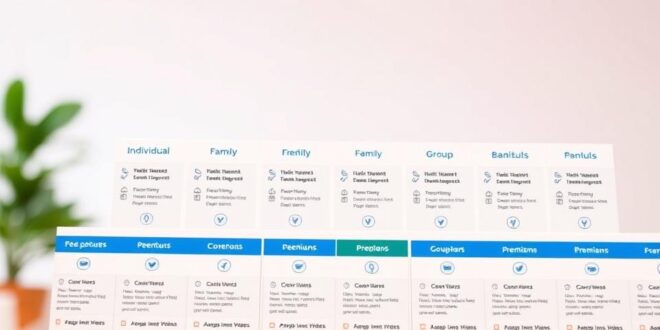Table of Contents
Finding the right health insurance plans can be tough. But, with the right help, you can find your way through all the options.
It’s important to know what you need and look at different plans. This helps you find the best coverage for you and your family.
Think about coverage, cost, and who’s in the network. This way, you can choose the best insurance near me for you.
Key Takeaways
- Understand your health insurance needs before selecting a plan.
- Explore different types of health insurance plans available.
- Compare coverage, cost, and provider networks.
- Consider factors that affect your insurance premiums.
- Make an informed decision when choosing the best insurance plan.
Understanding Your Health Insurance Needs
It’s important to know what health insurance you need. This helps you pick a plan that fits you and your family. You need to think about a few things to make a good choice.
Assessing Your Medical Requirements
First, look at your health and any ongoing medical issues. Think about how often you see doctors and any medicines you take. This will help you figure out how much coverage you need.
Determining Your Budget Constraints
Then, check your finances to see how much you can spend on insurance. Look at your income, expenses, and savings plans. Having a budget will help you find the right plan.
Evaluating Family Coverage Options
If you have a family, think about their health needs too. Look for plans that cover kids and maternity care. Some important things to consider are:
- The number of family members to be covered
- Any specific health needs of your family members
- The cost of adding family members to the plan
By looking at your medical needs, budget, and family coverage, you can find the right health insurance plan. It will meet your unique needs.
Essential Health Insurance Terminology
Understanding health insurance terms is key. It helps you choose the right plan for you.
Premiums, Deductibles, and Copays Explained
Premiums are your monthly health insurance payments. Deductibles are what you pay before insurance starts. Copays are fixed fees for services like doctor visits.
Understanding Out-of-Pocket Maximums
The out-of-pocket maximum is your yearly cap on healthcare costs. Once you hit this, your insurance covers everything.
Network Types and Coverage Limitations
Network types, like HMOs and PPOs, show which doctors you can see. Knowing these networks helps avoid surprise medical bills.
Types of Health Insurance Plans Available
It’s important to know about the different health insurance plans. Each plan has its own benefits and features. This knowledge helps you make a smart choice.
Health Maintenance Organizations (HMOs)
HMOs cover a wide range of healthcare services within a network. You need a primary care doctor’s referral to see specialists. HMOs are great for those who want to save money and don’t mind seeing only certain doctors.
Preferred Provider Organizations (PPOs)
PPOs give you more freedom to choose your doctors. You can see doctors outside the network, but it costs more. PPOs are perfect for people who like to have more control over their healthcare.
Exclusive Provider Organizations (EPOs)
EPOs mix HMO and PPO features. They have a network of preferred doctors but don’t cover out-of-network care unless it’s an emergency. EPOs are good for those who want a balance between cost and choice.
Point of Service (POS) Plans
POS plans let you choose between network and out-of-network care. The cost varies. POS plans are great for those who want flexibility in their healthcare choices.
High Deductible Health Plans (HDHPs)
HDHPs have lower premiums but higher deductibles. They’re best for healthy people who want to save on premiums. HDHPs can be paired with Health Savings Accounts (HSAs) for extra tax benefits.
A health insurance expert says, “Choosing the right plan depends on your healthcare needs and budget. Match them to the best plan for you.”
“The right health insurance plan can make a big difference in your health and finances.”
How to Find Health Insurance Near Me
Finding health insurance near you is easier than you think. There are many online tools and local resources to help. Whether you need individual coverage or family plans, you have several options.
Using Online Marketplace Tools
Online marketplaces like HealthCare.gov let you compare health insurance plans. You can filter by coverage area, deductible, and premium costs. Comparing plans online saves time and helps you choose wisely.
Contacting Local Insurance Brokers
Local insurance brokers offer insights into local plans. They provide personalized advice and help with insurance complexities. Working with a local broker is great if you’re new or have specific needs.
Exploring Employer-Sponsored Options
If you work, check out employer-sponsored health insurance plans. Many employers offer these as part of their benefits. These plans are often cheaper and offer good coverage.
Checking Eligibility for Government Programs
You might qualify for government health insurance like Medicaid or CHIP. These programs offer affordable coverage. Government programs have specific rules, so check them carefully.
- Use online marketplace tools to compare health insurance plans.
- Contact local insurance brokers for personalized guidance.
- Explore employer-sponsored health insurance options if available.
- Check your eligibility for government health insurance programs.
By looking into these options, you can find health insurance that fits your needs and budget.
Navigating the Health Insurance Marketplace
It’s important to know how to use the health insurance marketplace. This helps you find the right coverage for you and your family. There are several steps to make this easier.
Step-by-Step Guide to Creating an Account
To begin, you need to make an account on the health insurance marketplace website. You’ll give basic info like your name, address, and income. Having your Social Security number and tax return information ready can make things easier.
Understanding Open Enrollment Periods
Open enrollment periods are when you can pick or change your health insurance plan. This usually happens once a year. Knowing the exact dates is key to not miss your chance to change your coverage.
Qualifying for Special Enrollment Periods
Some life events, like losing your job or getting married, can qualify you for a special enrollment period. This lets you enroll or change your insurance outside the regular open enrollment time.
Uploading Required Documentation
To finish your application, you’ll need to upload certain documents. These include proof of income, identification, and citizenship status. Having these documents ready can prevent delays in your application.
| Required Documents | Purpose |
|---|---|
| Proof of Income | To determine eligibility for subsidies |
| Identification | To verify your identity |
| Citizenship Status | To confirm eligibility for health insurance |
By following these steps and being prepared, you can better navigate the health insurance marketplace. This way, you can find a plan that fits your needs.
Comparing Health Insurance Plans Effectively
To find the right health insurance plan, compare different options. Look at several key factors. This will help you choose a plan that meets your healthcare needs and budget.
Creating a Comparison Spreadsheet
Use a spreadsheet to compare health insurance plans. List the plans you’re looking at on the top row. Then, list important features like premiums, deductibles, and copays in columns. This makes it easy to see the differences between plans.
Verifying Provider Networks for Your Area
Make sure the plan’s provider network includes your doctors and hospitals. Check the insurance company’s website for their provider directory. Make sure the network is strong and includes specialists you might need.

Analyzing Prescription Drug Formularies
If you take ongoing medication, check the plan’s prescription drug formularies. See if your medications are covered and what tier they are. This affects your costs.
Calculating Total Potencial Costs
Calculate the total costs of each plan. Include premiums, deductibles, copays, and any other expenses. Use online tools or talk to an insurance broker for help.
By following these steps, you can compare health insurance plans well. Choose the one that best fits your needs and budget.
Local Resources for Health Insurance Assistance
Finding the right health insurance can be tough. But, you don’t have to face it alone. Local resources are here to help. If you need help with health insurance options, there are many places to turn to.
Contacting Your State Insurance Department
Your state’s insurance department is key. They help you understand health insurance rules and options in your area. They can also help with any problems you have with your insurance.
Finding Community Health Centers
Community health centers offer help with health insurance. They may have free or low-cost health services. They are a great place to go if you need help.
Working with Insurance Navigator Programs
Insurance navigator programs help you understand your health insurance choices. They are unbiased and can give you personalized advice. They can help you find a plan that fits your needs.
Attending Local Health Insurance Workshops
Local health insurance workshops are full of useful information. They have experts who can answer your questions. They can help you pick the right health insurance plan.
| Resource | Description | Benefits |
|---|---|---|
| State Insurance Department | Provides information on insurance regulations and licensed providers | Helps resolve complaints, understand local insurance laws |
| Community Health Centers | Offers health services and assistance with insurance enrollment | Free or low-cost health services, insurance guidance |
| Insurance Navigator Programs | Unbiased guidance on health insurance options and enrollment | Personalized assistance, helps choose the right plan |
| Local Health Insurance Workshops | Educational events featuring expert speakers on health insurance | Valuable insights, answers to questions, guidance on plan selection |
By using these local resources, you can make better choices about your health insurance. This way, you can find a plan that fits your needs and budget.
Conclusion
Finding the right health insurance plan is key to getting quality healthcare for you and your family. Knowing your medical needs, budget, and family coverage is important. This helps you make a smart choice.
When looking at health insurance, compare plans carefully. Look at provider networks, prescription drug lists, and total costs. If you need help, reach out to your state insurance department or local health centers.
With the right plan, you’ll feel secure against unexpected medical bills. Take your time and don’t rush. Follow these tips to find a plan that fits your needs and offers the coverage you deserve.
FAQ
What is health insurance, and why do I need it?
How do I assess my medical requirements for health insurance?
What is the difference between a Health Maintenance Organization (HMO) and a Preferred Provider Organization (PPO)?
How do I compare health insurance plans effectively?
What is the Health Insurance Marketplace, and how do I navigate it?
Can I get assistance with health insurance enrollment?
What are the different types of health insurance plans available?
How do I determine my budget constraints for health insurance?
What is the open enrollment period for health insurance?
Can I enroll in a health insurance plan outside of the open enrollment period?




